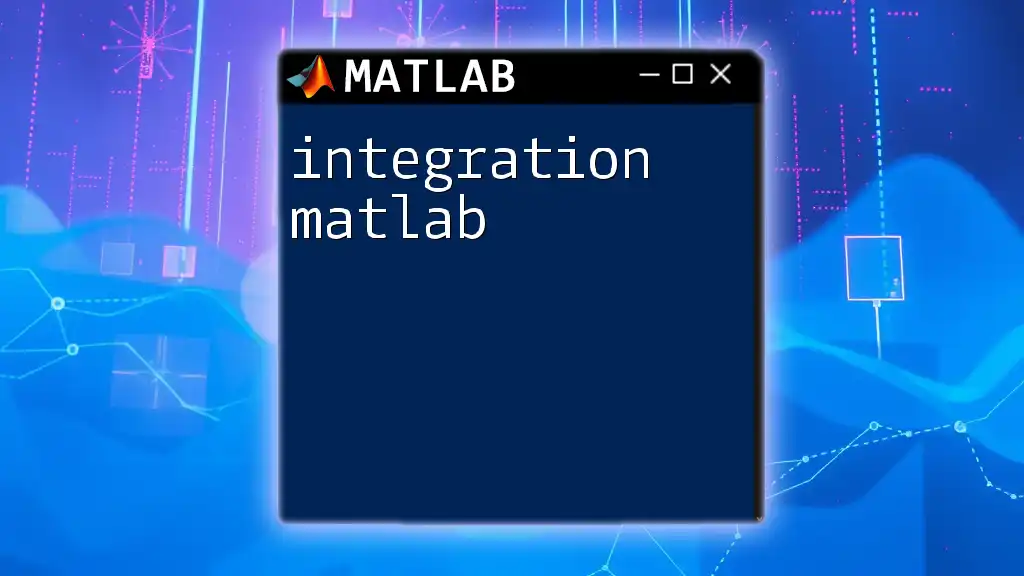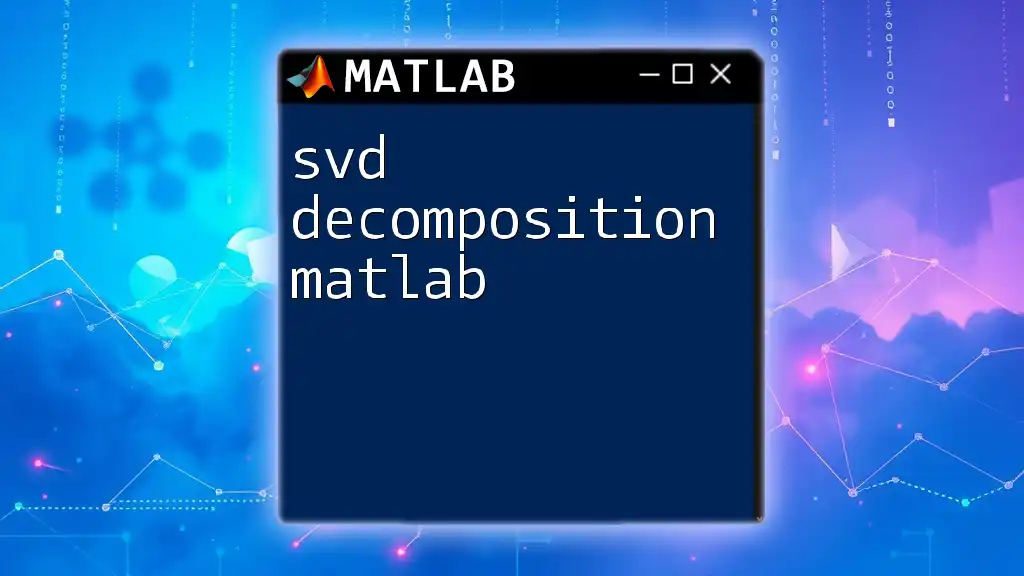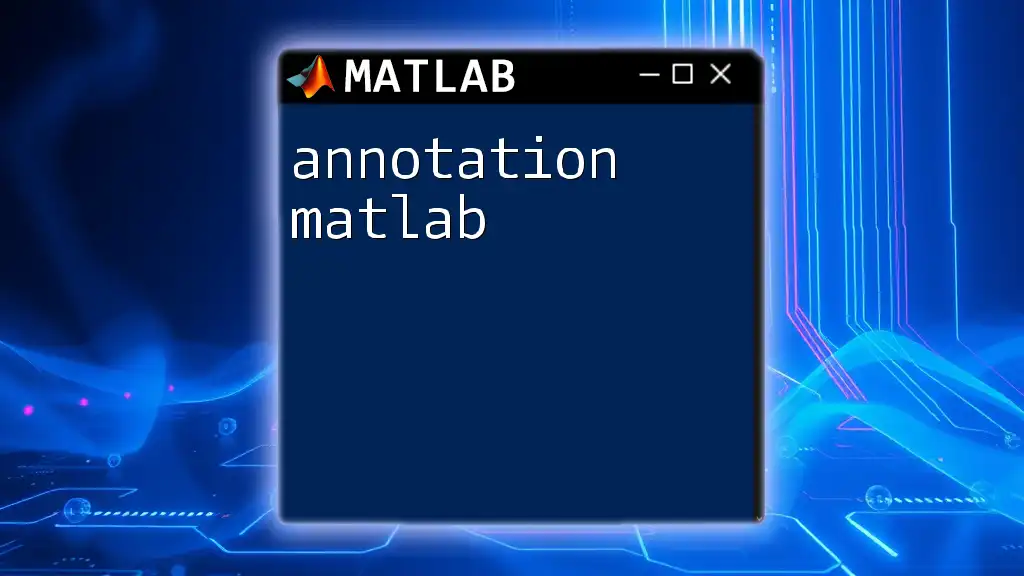To solve a set of equations in MATLAB, you can use the `linsolve` function or the backslash operator (`\`) to find the solution for a system of linear equations represented in matrix form.
Here's a code snippet demonstrating how to solve a simple set of equations:
A = [2, 3; 4, 5]; % Coefficient matrix
B = [5; 11]; % Right-hand side matrix
X = A \ B; % Solve for X
disp(X); % Display the solution
Understanding Sets of Equations
A set of equations typically refers to multiple equations that need to be solved simultaneously. These can be categorized into linear and nonlinear equations. Solving these equations is crucial in many fields, including engineering, data analysis, and economic modeling, as they allow for better understanding and prediction of complex systems.

Basics of MATLAB Commands for Solving Equations
MATLAB is a powerful computational tool that simplifies the process of solving equations. Certain key functions in MATLAB are specifically designed for this purpose.
Key Functions for Solving Equations
`linprog()`
The `linprog()` function is utilized for solving linear programming problems. It offers a robust method to find the minimum of a linear objective function while satisfying linear equality and inequality constraints.
Example of use:
Suppose you want to minimize a function subject to certain constraints. You can define your objective function and constraints, and `linprog()` will give you the solution efficiently.
`fsolve()`
The `fsolve()` function is another versatile tool used for finding roots of nonlinear equations. This function can handle complex equations where the shape isn't a straight line, providing a numerical solution based on initial guesses.
Code snippet demonstrating its application:
% Define the function with nonlinear equations
fun = @(x) [x(1)^3 - 2*x(2) + x(1) - 7;
x(1) + x(2)^2 - 9];
x0 = [1; 1]; % Initial guess
x = fsolve(fun, x0); % Solve the equations
disp('The solution is:');
disp(x);
Using Symbolic Math Toolbox
The Symbolic Math Toolbox allows for symbolic computation, enabling users to solve equations symbolically. The `solve()` function can be used for finding exact solutions to sets of equations.

Step-by-Step Guide on Solving Linear Equations in MATLAB
Formulating the Problem
Linear equations can be represented in matrix form. To solve a set of linear equations, you should express them as:
\[ A \cdot x = b \]
Where \( A \) is the coefficient matrix, \( x \) is the variable vector to solve for, and \( b \) is the constant vector.
For example, the following set of equations:
- \( 3x - 2y = 1 \)
- \( x + 5y = 10 \)
can be expressed in matrix form as:
\[ A = \begin{bmatrix} 3 & -2 \\ 1 & 5 \end{bmatrix}, \quad b = \begin{bmatrix} 1 \\ 10 \end{bmatrix} \]
Using MATLAB for Solution
You can use the backslash (`\`) operator, which efficiently computes the solution to linear equations.
Code snippet to create matrices and solve:
% Defining the coefficient matrix and constants
A = [3 -2; 1 5]; % Coefficient matrix
b = [1; 10]; % Constant vector
% Solving the system of equations
x = A\b; % x now holds the solution
disp('The solution is:');
disp(x);
Verifying the Solution
To verify that the solution satisfies the original equations, you can substitute the values into the equations and see if the left-hand side equals the right-hand side.
Code snippet to verify:
% Verification
left_side1 = A(1,1)*x(1) + A(1,2)*x(2);
left_side2 = A(2,1)*x(1) + A(2,2)*x(2);
disp('Verification results:');
disp(['Equation 1: ', num2str(left_side1), ' = ', num2str(b(1))]);
disp(['Equation 2: ', num2str(left_side2), ' = ', num2str(b(2))]);

Step-by-Step Guide on Solving Nonlinear Equations in MATLAB
Formulating Nonlinear Equations
Nonlinear equations cannot be directly solved using simple linear matrix techniques. Instead, they may involve powers or other non-linear functions, requiring specific methods to find solutions.
For example, consider the equations:
- \( x^2 + y = 3 \)
- \( x + y^2 = 5 \)
These can be represented as a function to be solved.
Using `fsolve()` for Nonlinear Systems
To solve these equations, `fsolve()` can be deployed, which requires the definition of the equations in a function format.
Detailed explanation of `fsolve()`: You need to create an anonymous function for your equations and provide an initial guess.
Code snippet showing how to set options and initial guesses:
% Define the function for the nonlinear equations
fun = @(x) [x(1)^2 + x(2) - 3;
x(1) + x(2)^2 - 5];
x0 = [1; 1]; % Initial guess for the solution
% Solving the nonlinear equations
options = optimset('Display', 'iter'); % Options for displaying iterations
[x, fval] = fsolve(fun, x0, options); % Solve the equations
disp('The solution is:');
disp(x);
Analyzing the Output
The output from `fsolve()` provides the values of \( x \) and \( y \) that satisfy both equations. Understanding how to analyze these outputs will help you interpret the results in a real-world context.

Advanced Topics in Solving Equations with MATLAB
Multiple Methods of Solving the Same Problem
Often, multiple methods can be applied to solve the same problem. It's insightful to compare these methods to understand their efficiency and accuracy.
For example, you may find different outputs from symbolic solutions versus numerical approaches. The choice of method might depend on problem specifics such as complexity or the precision required.
Graphical Interpretation of Solutions
Visualizing your equations and their solutions can provide intuitive insights. MATLAB’s plotting capabilities allow you to graph your equations and observe their intersections.
Example of plotting equations:
% Example of plotting a 2D representation
fimplicit(@(x,y) x^2 + y - 3, 'r'); % First equation
hold on;
fimplicit(@(x,y) x + y^2 - 5, 'b'); % Second equation
legend('x^2 + y = 3', 'x + y^2 = 5');
title('Graphical Representation of Equations');
xlabel('x-axis');
ylabel('y-axis');
grid on;

Common Errors and Troubleshooting
Common Mistakes When Solving Sets of Equations
While working with MATLAB, users commonly encounter mistakes such as misrepresenting equations, overlooking matrix dimensions, or providing incorrect initial guesses. It’s essential to double-check your formulations and the dimensions of matrices involved.
Best Practices
To streamline your coding experience in MATLAB, always:
- Validate your expressions before running them.
- Break down complex problems into smaller, manageable parts.
- Use comments in your code for clarity.

Conclusion
This guide outlines the fundamental processes and commands to solve a set of equations in MATLAB effectively. Whether you're working with linear or nonlinear problems, MATLAB offers robust functions to help uncover solutions swiftly and accurately.
By integrating the concepts and examples outlined in this article, you can leverage MATLAB’s powerful capabilities to address various equations, ensuring efficient problem solving in your academic or professional pursuits. Continue to explore and practice these methods to sharpen your skills further!

















